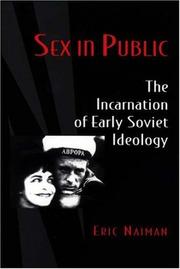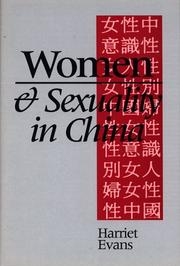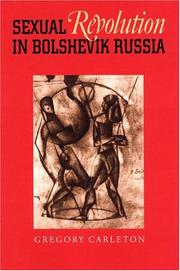| Listing 1 - 10 of 10 |
Sort by
|

ISBN: 0691026262 Year: 1997 Publisher: Princeton (N.J.) : Princeton university press,
Abstract | Keywords | Export | Availability | Bookmark
 Loading...
Loading...Choose an application
- Reference Manager
- EndNote
- RefWorks (Direct export to RefWorks)
Communism and sex --- Soviet Union --- History
Book
ISBN: 9791039900393 Year: 2022 Publisher: Paris : Syllepse,
Abstract | Keywords | Export | Availability | Bookmark
 Loading...
Loading...Choose an application
- Reference Manager
- EndNote
- RefWorks (Direct export to RefWorks)
Pour Federico Zappino, bien plus qu'une orientation sexuelle, l'hétérosexualité "définit les hommes et les femmes en tant que tels, d'une manière qui ne se distingue pas de l'inégalité et de la hiérarchie". La thèse défendue ici fait de la subversion de l'hétérosexualié un élément du bouleversement des fondements des inégalités de genre et de sexe, dont se nourrit le capitalisme. L'auteur fait le pari de la nécessité d'une lutte commune pour toutes celles et ceux en proie à sa domination. L'objectif de cet ouvrage n'est donc pas seulement de décortiquer les mécanismes du "mode de production hétérosexuel" : c'est une invitation à discuter les espaces de luttes communs entre les minorités de genre et de sexe, ainsi que la possibilité de nouer des alliances entre groupes sociaux avec comme horizon une société sans classes. C'est autour de ce fil conducteur que, dans le contexte de l'essor des mouvements féministes post-#Metoo et de la pensée intersectionnelle, l'auteur propose une réflexion originale et stimulante, naviguant entre les théoriciennes queer, de Judith Butler à Monique Wittig, et les figures de la pensée marxiste telles qu'Antonio Gramsci ou Toni Negri. Federico Zappino, dont l'ouvrage a connu un retentissement certain en Italie, alterne avec aisance et ironie réflexions philosophiques et exemples concrets. Il s'agit de son premier livre publié en français. "Ne cherchez pas les bureaux de cette institution [l'hétérosexualité] dans un gratte-ciel du centre-ville ou dans un quelconque ministère du gouvernement ? ; son influence est à ce point omniprésente dans la société actuelle qu'on pourrait presque affirmer qu'elle est dans l'air que nous respirons" (Mariana Valverde).
Théorie queer --- Minorités sexuelles --- Communisme et sexualité --- Queer theory --- Sexual minorities. --- Communism and sex.
Book
ISBN: 9780745691145 9780745691152 Year: 2016 Publisher: Cambridge : Polity,
Abstract | Keywords | Export | Availability | Bookmark
 Loading...
Loading...Choose an application
- Reference Manager
- EndNote
- RefWorks (Direct export to RefWorks)
Communism and love. --- Communism and sex. --- Love --- Radicalism. --- Revolutions. --- Political aspects.
Book
ISBN: 0822970872 0822842380 Year: 2005 Publisher: Pittsburgh : Baltimore, Md. : University of Pittsburgh Press, Project MUSE,
Abstract | Keywords | Export | Availability | Bookmark
 Loading...
Loading...Choose an application
- Reference Manager
- EndNote
- RefWorks (Direct export to RefWorks)
Communism and sex --- Sex customs --- History. --- Soviet Union --- History --- Social life and customs.

ISBN: 0826409229 Year: 1997 Publisher: New York (N.Y.): Continuum
Abstract | Keywords | Export | Availability | Bookmark
 Loading...
Loading...Choose an application
- Reference Manager
- EndNote
- RefWorks (Direct export to RefWorks)
Communism and sex --- Discourse analysis --- Sex instruction --- Sex --- Women and communism --- Women --- Political aspects --- Sexual behavior

ISBN: 9780822942382 0822942380 Year: 2005 Publisher: Pittsburgh : University of Pittsburgh Press,
Abstract | Keywords | Export | Availability | Bookmark
 Loading...
Loading...Choose an application
- Reference Manager
- EndNote
- RefWorks (Direct export to RefWorks)
Sex customs --- Communism and sex --- Vie sexuelle --- Communisme et sexualité --- Soviet Union --- Soviet Union --- URSS --- URSS --- Social life and customs. --- History --- Moeurs et coutumes --- Histoire
Book
ISBN: 9782370711106 Year: 2017 Publisher: Montreuil : le Temps des cerises,
Abstract | Keywords | Export | Availability | Bookmark
 Loading...
Loading...Choose an application
- Reference Manager
- EndNote
- RefWorks (Direct export to RefWorks)
Communism and sex --- Women and communism --- Feminism --- Feminism --- Communisme et sexualité --- Femmes et communisme --- Féminisme --- Féminisme --- Political aspects --- History --- History --- Aspect politique --- Histoire --- Histoire --- Kollontaĭ, A.
Book
ISBN: 9789004177444 Year: 2010 Publisher: Leiden Brill
Abstract | Keywords | Export | Availability | Bookmark
 Loading...
Loading...Choose an application
- Reference Manager
- EndNote
- RefWorks (Direct export to RefWorks)
Communism and sex --- Gender identity in the theater --- Sex in the theater --- Theater --- Women and communism --- Women in the theater --- Political aspects --- History
Book
ISBN: 0745613985 0745613977 Year: 1997 Publisher: Cambridge, UK Polity Press
Abstract | Keywords | Export | Availability | Bookmark
 Loading...
Loading...Choose an application
- Reference Manager
- EndNote
- RefWorks (Direct export to RefWorks)
Communism and sex --- Discourse analysis --- Sex --- Sex instruction --- Women --- Women and communism --- Mass media and sex --- Communisme et sexualité --- Analyse du discours --- Sexualité --- Education sexuelle --- Femmes --- Femmes et communisme --- Médias et sexualité --- Political aspects --- Sexual behavior --- Aspect politique --- Comportement sexuel --- Communisme et sexualité --- Sexualité --- Médias et sexualité --- China --- communism and sex
Book
ISBN: 1282949845 9786612949845 9047430883 9004177442 Year: 2010 Publisher: Leiden [Netherlands] ; Boston : Brill,
Abstract | Keywords | Export | Availability | Bookmark
 Loading...
Loading...Choose an application
- Reference Manager
- EndNote
- RefWorks (Direct export to RefWorks)
Here is a convincing reflection that changes our understanding of gender in Maoist culture, esp. for what critics from the 1990's onwards have termed its ‘erasure’ of gender and sexuality. In particular the strong heroines of the yangbanxi, or ‘model works’ which dominated the Cultural Revolution period, have been seen as genderless revolutionaries whose images were damaging to women. Drawing on contemporary theories ranging from literary and cultural studies to sociology, this book challenges that established view through detailed semiotic analysis of theatrical systems of the yangbanxi including costume, props, kinesics, and various audio and linguistic systems. Acknowledging the complex interplay of traditional, modern, Chinese and foreign gender ideologies as manifest in the 'model works', it fundamentally changes our insights into gender in Maoist culture.
Theater --- Gender identity in the theater --- Sex in the theater. --- Women in the theater --- Women and communism --- Communism and sex --- Sex and communism --- Sex --- Communism and women --- Communism --- Stage sex --- Dramatics --- Histrionics --- Professional theater --- Stage --- Theatre --- Performing arts --- Acting --- Actors --- Political aspects --- History
| Listing 1 - 10 of 10 |
Sort by
|

 Search
Search Feedback
Feedback About UniCat
About UniCat  Help
Help News
News